Featured Comment
Tried this! What an amazing refreshing dish. Love how vibrant it is. Truly a feast for the eyes and stomach. prosciutto goes really well with it. Thank you for sharing 💕
– @darienme (from YouTube)
What do you do when your shiso plants produce faster than you can eat?
I’ve already created several shiso leaf recipes like summer vegetable salad, shiso dressing, and shiso tempura, but what if I told you that you could use these fragrant leaves to whip up a quick and delicious lunch?
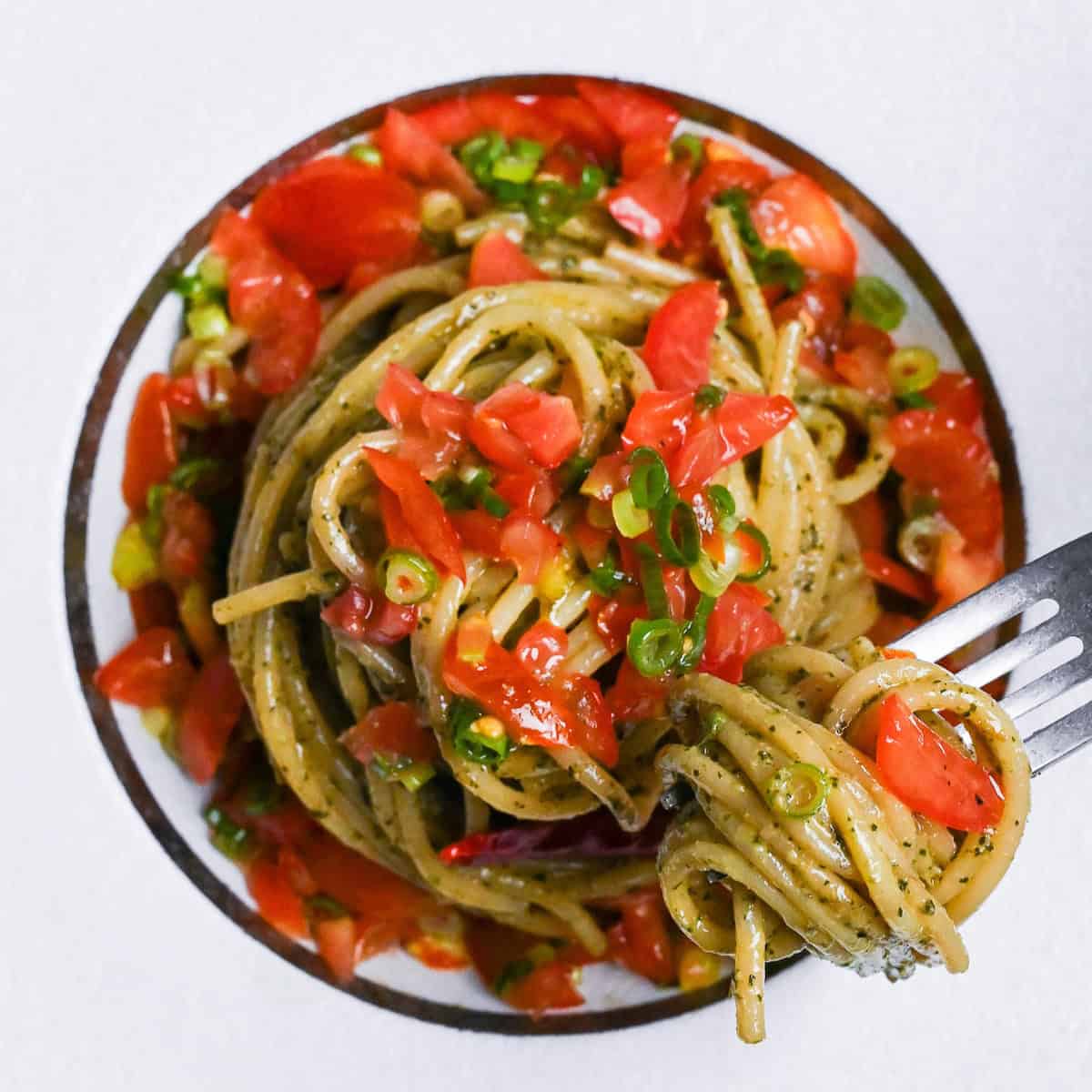
Shiso pesto pasta
Recipe Snapshot
- What is it? Japanese-Italian fusion chilled pasta that uses up loads of shiso leaves in a vibrant pesto with marinated tomatoes.
- Flavor profile: Herbaceous, Refreshing, Nutty
- Why you’ll love this recipe: It finally gives you a delicious way to use up all that shiso before it goes bad. No more guilt-inducing herb waste!
- Must-haves: Shiso leaves, Food Processor (or small blender), Mini Tomatoes
- Skill Level: Medium
- Suitable for Meal Prep: Partially
Summarize & Save this content on:
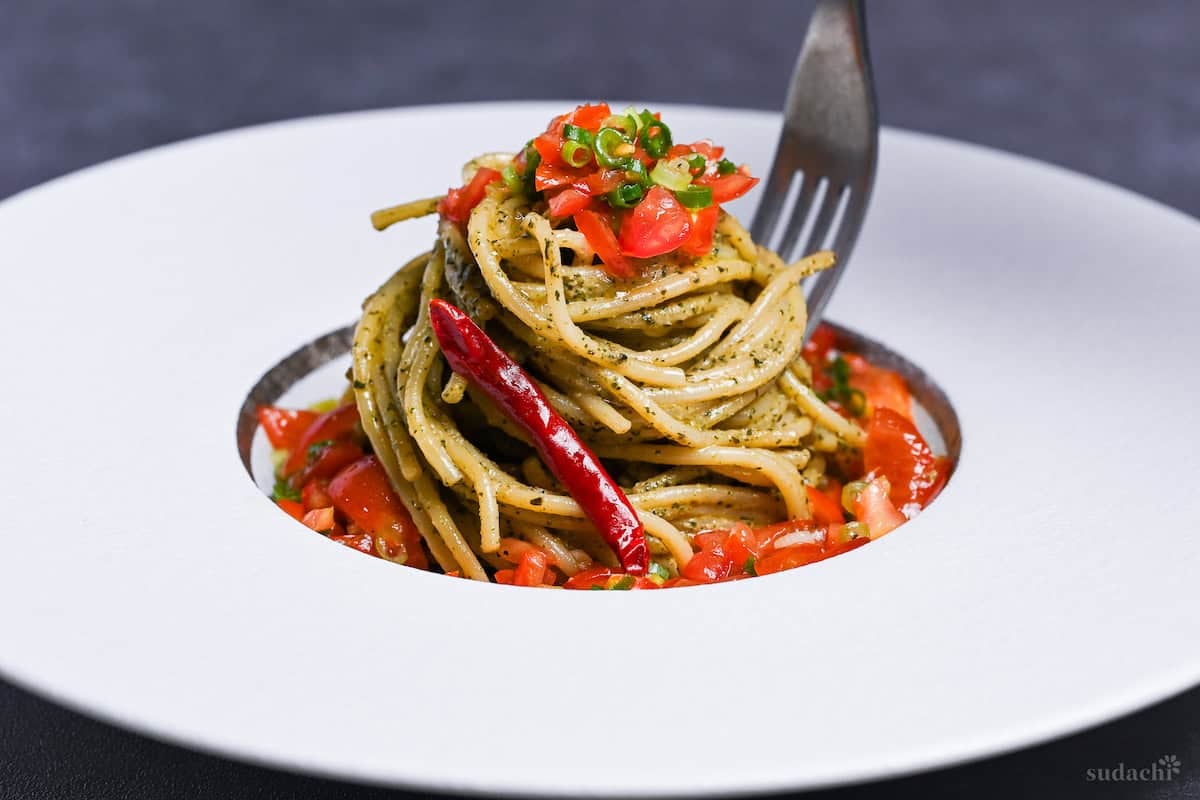
How I Developed This Recipe
I had a lightbulb moment when I was staring at yet another bundle of wilting shiso.
I have plenty of wafu pasta recipes already, but I realised I was lacking a refreshing spaghetti dish that can be enjoyed in the summer.
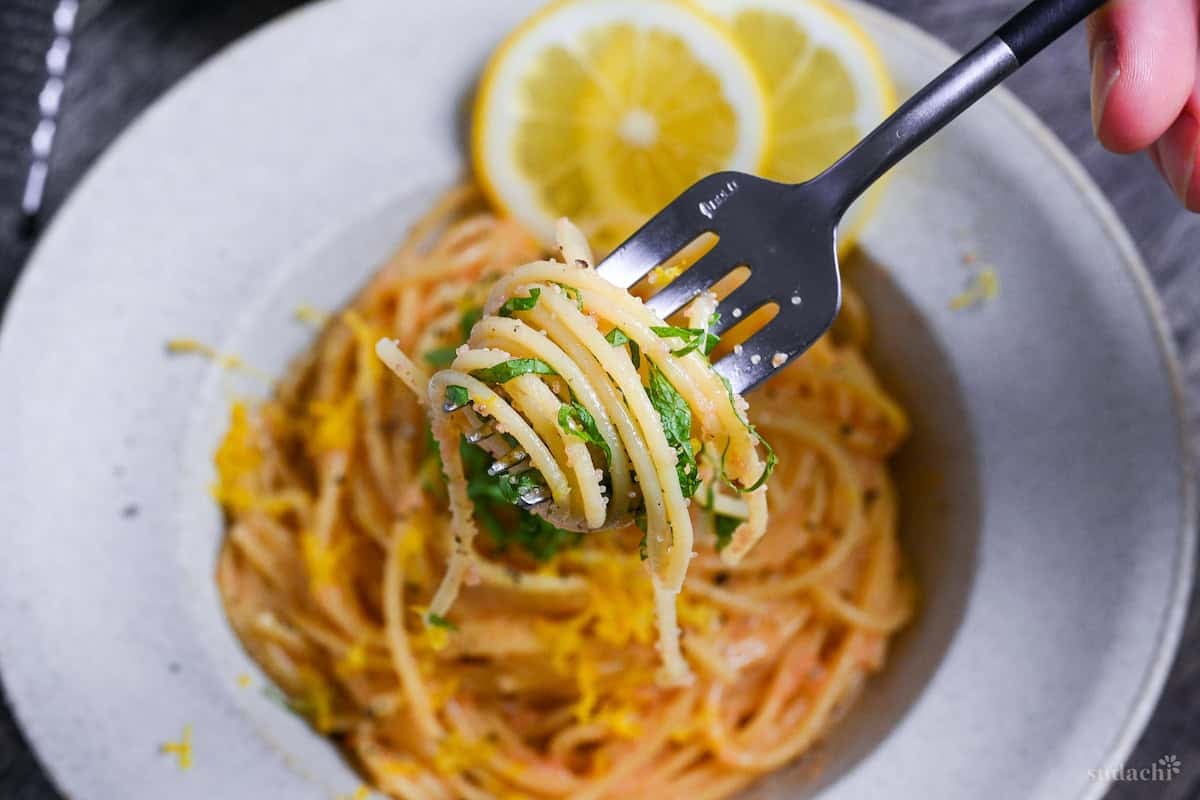
My mission was to create something that devoured excess herbs, looked stunning enough for a nice dinner, and actually made you crave pasta in swelting weather.
This recipe genuinely solves the “too much shiso” problem while delivering something you’ll actually want to make again and again.
Shiso Pesto Pasta Ingredients
What You’ll Need for Shiso Pesto
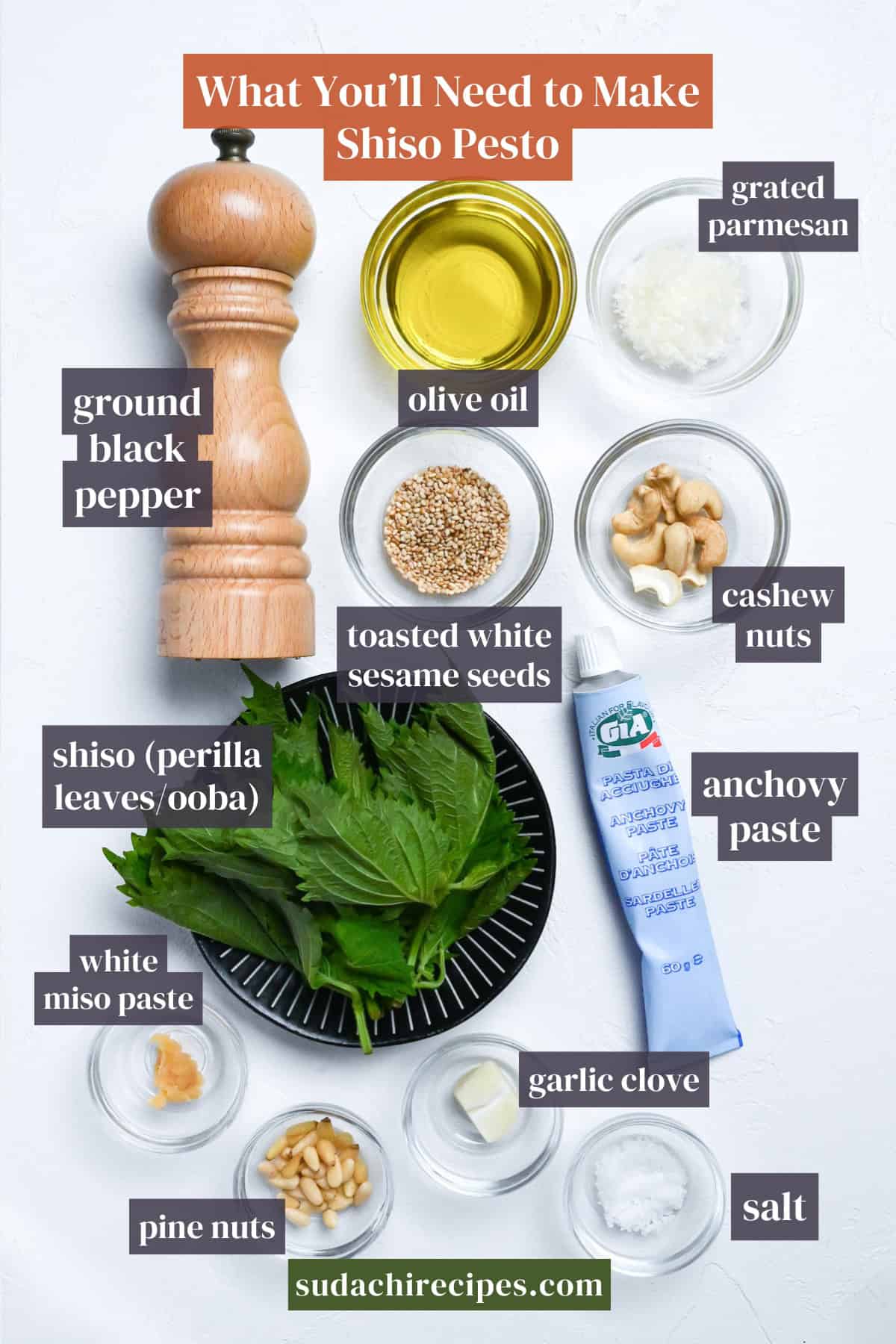
- Shiso leaves (perilla): Fresh green shiso is what makes this pesto uniquely Japanese. If you don’t have shiso on hand, basil is a natural stand-in and still delivers a satisfying sauce. This is your chance to use up those wilting shiso leaves from your garden or market haul.
- Cashews & Pine nuts: I use both for extra richness and texture, but you can absolutely use just one type.
- White miso paste: This subtle addition deepens the umami and anchors the pesto in more Japanese flair. To choose the right brand, check out my guide to the best white miso paste options available.
What You’ll Need for Shiso Pesto Pasta
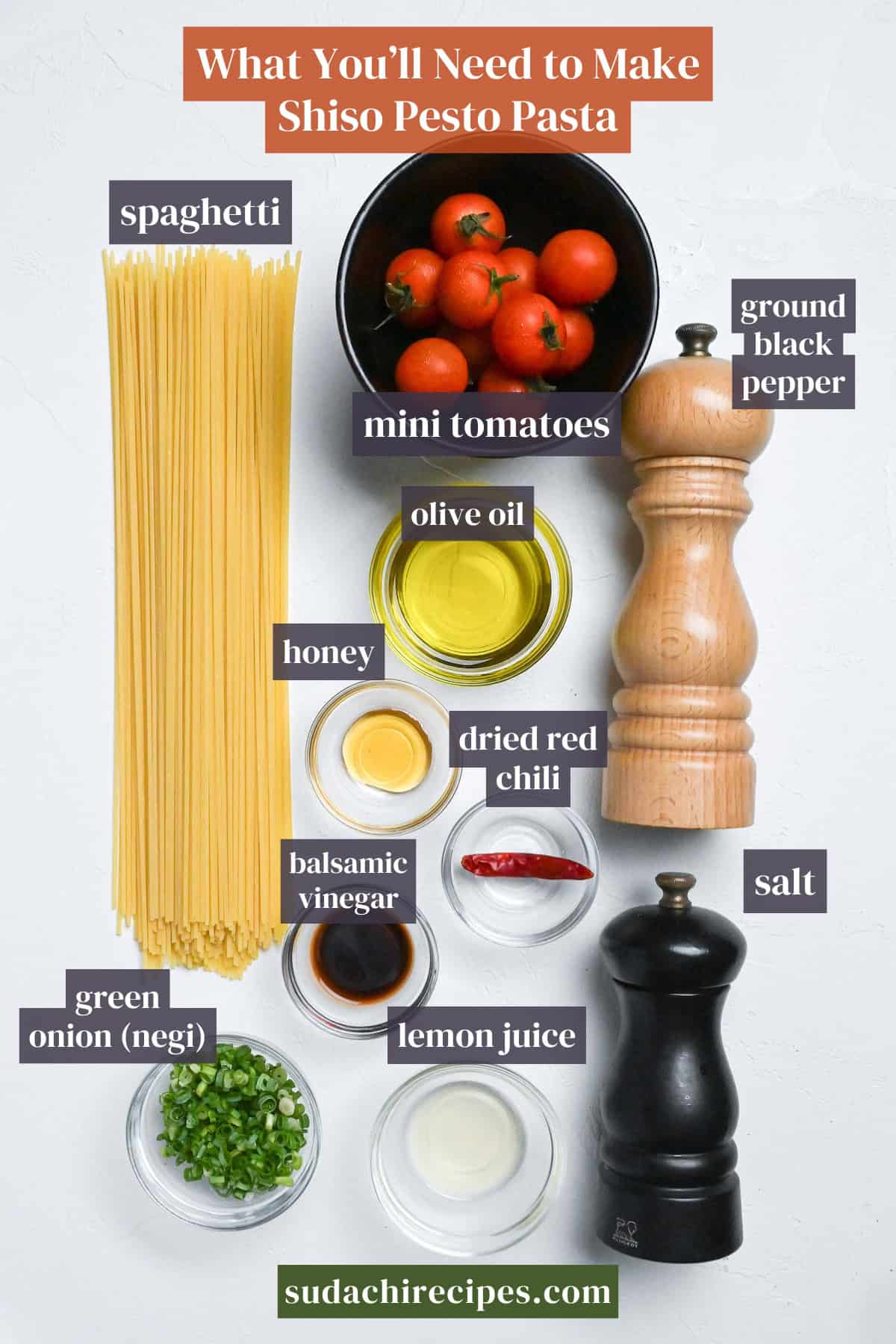
- Mini tomatoes: Small, sweet varieties like cherry, grape, or sungold tomatoes are perfect here.
- Spaghettini: Thinner pasta is your friend for cold dishes! It twirls more elegantly and holds onto that silky pesto better than thick noodles. I used spaghettini, but capellini (even finer) or classic spaghetti also works if that’s what’s in your pantry.
Substitution Ideas
- Anchovy paste: Add soy sauce or more white miso paste.
- Cashew & pine nuts: While not a substitute, you don’t need to use both. Stick to one if that’s what you have.
- Grated Parmesan cheese: Pecorino cheese, powdered cheese, nutritional yeast (plant-based option).
Have trouble finding Japanese ingredients? Check out my ultimate guide to Japanese ingredient substitutes!
How to Make My Shiso Pesto Pasta
If you prefer to watch the process in action, check out my YouTube video of this shiso pesto pasta recipe!
i. Start by cutting your cherry tomatoes into fine rough chunks.
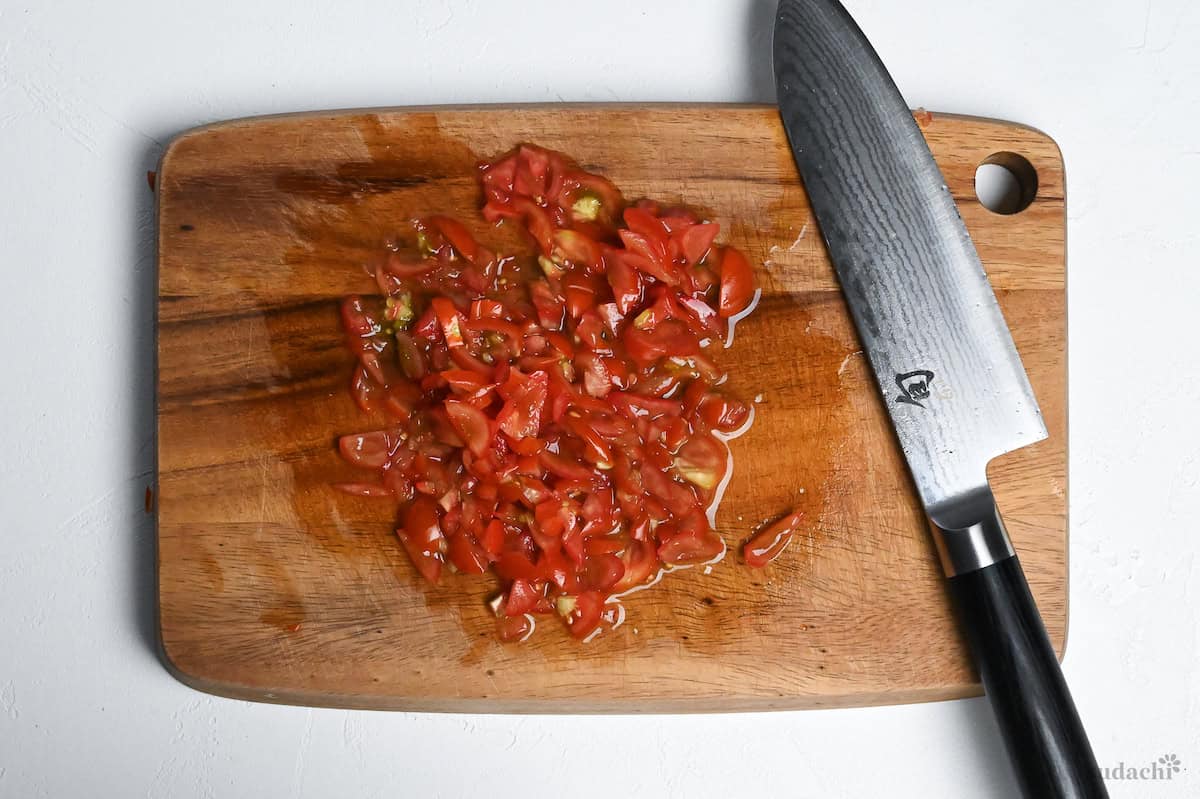
ii. Combine these cherry tomatoes, chopped green onions, halved and seeded red chili, olive oil, lemon juice, balsamic vinegar, honey, salt, and pepper in a small bowl.
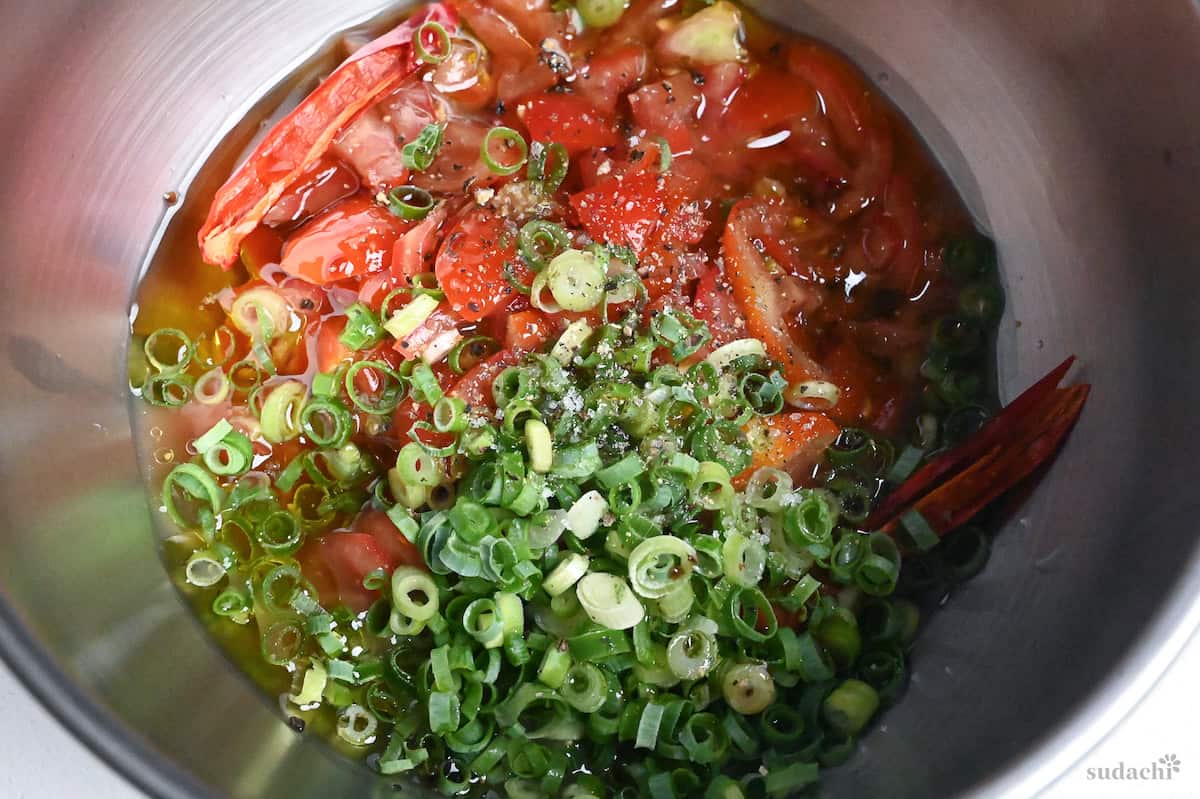
iii. Give everything a thorough stir and cover tightly, then slide it into the refrigerator for at least 30 minutes.
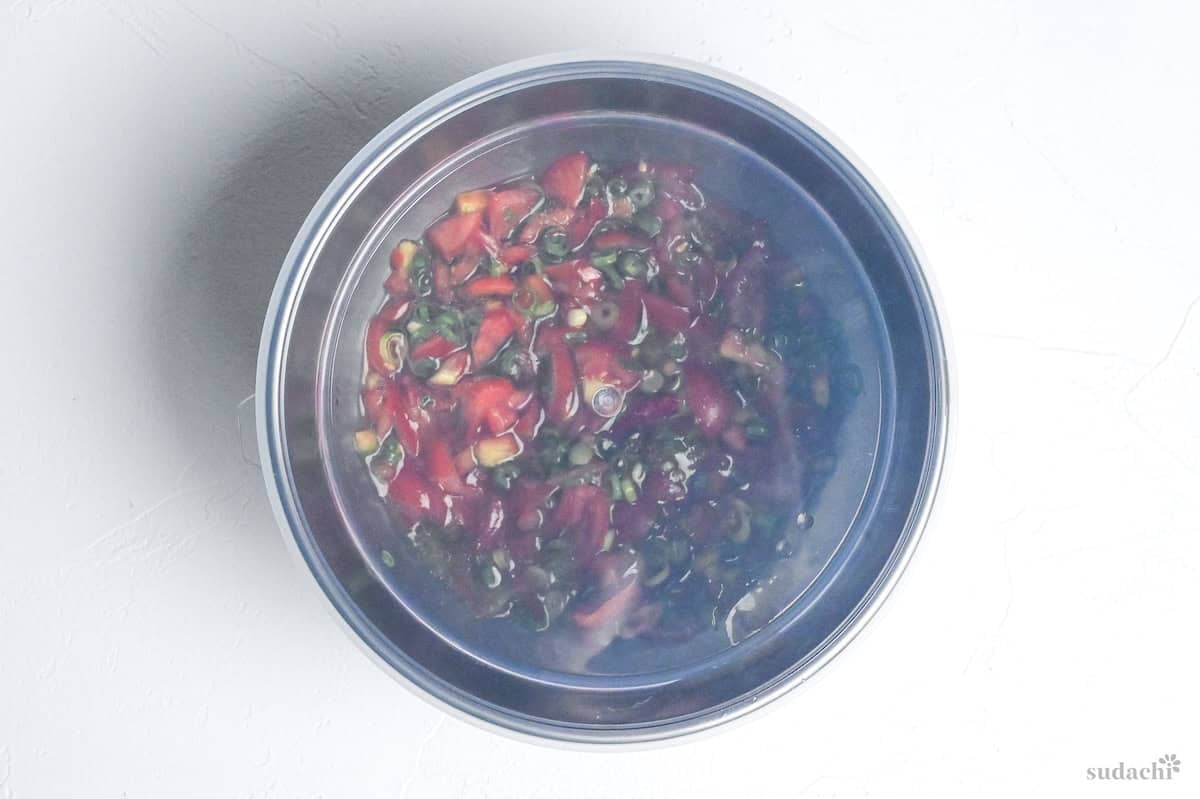
Pop your pasta bowls and forks into the fridge (or even freezer). Cold dishes served on cold plates stay refreshingly cool longer!
i. Add your shiso leaves, olive oil, roasted cashews, pine nuts, garlic (core removed), salt, white miso paste, grated Parmesan cheese, black pepper, white sesame seeds, and anchovy paste to your food processor and pulse until the mixture forms a chunky paste, then process continuously for about 30 seconds until you achieve a smooth, vibrant green sauce.
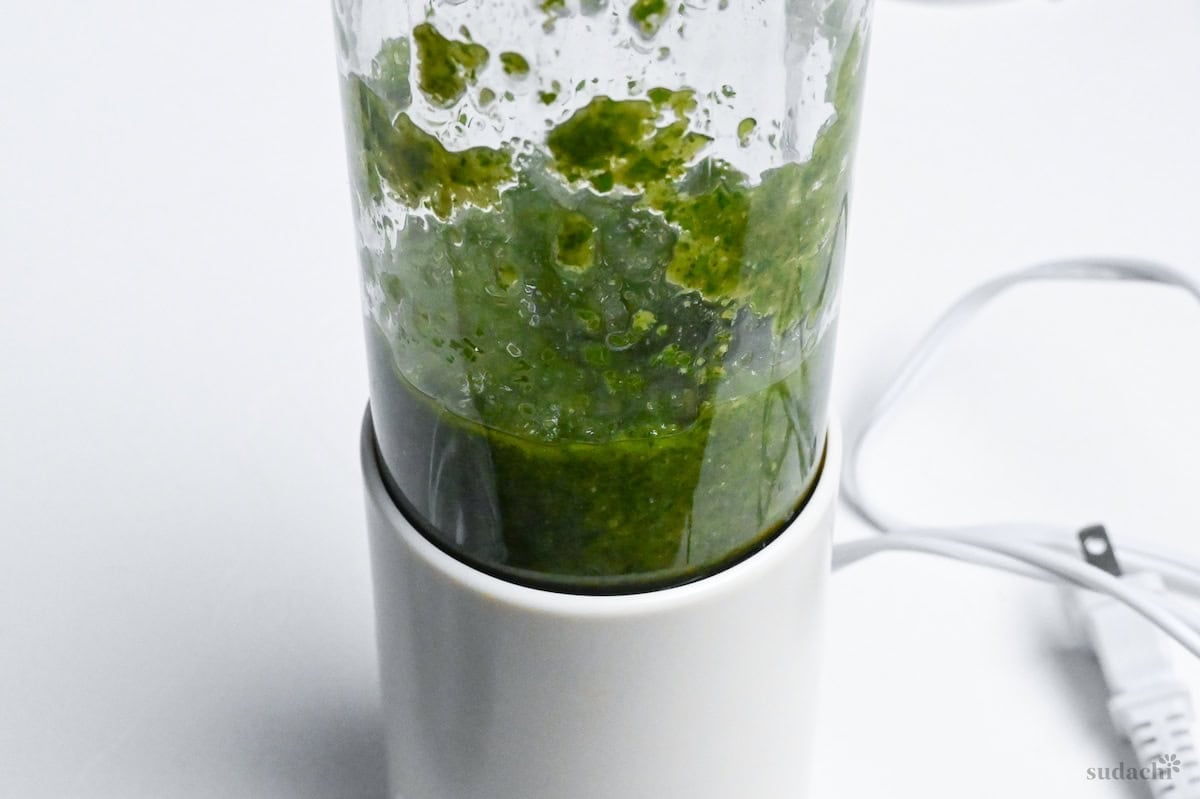
Shiso leaves are tougher than basil, so the food processor’s powerful blades are essential for breaking down those fibrous cell walls. The white miso acts as both a umami (& Japanese flair) booster and natural emulsifier, helping the oil bind smoothly with the other ingredients.
i. When the marinating time is almost finished, bring a large pot of water to a rolling boil and add salt until it tastes like mild seawater (about 1% salt by weight). Add your pasta and cook for about 1 minute longer than the package directions suggest.
While the pasta bubbles away, prepare a large bowl of ice water and set a colander nearby. You want everything ready before that timer goes off.
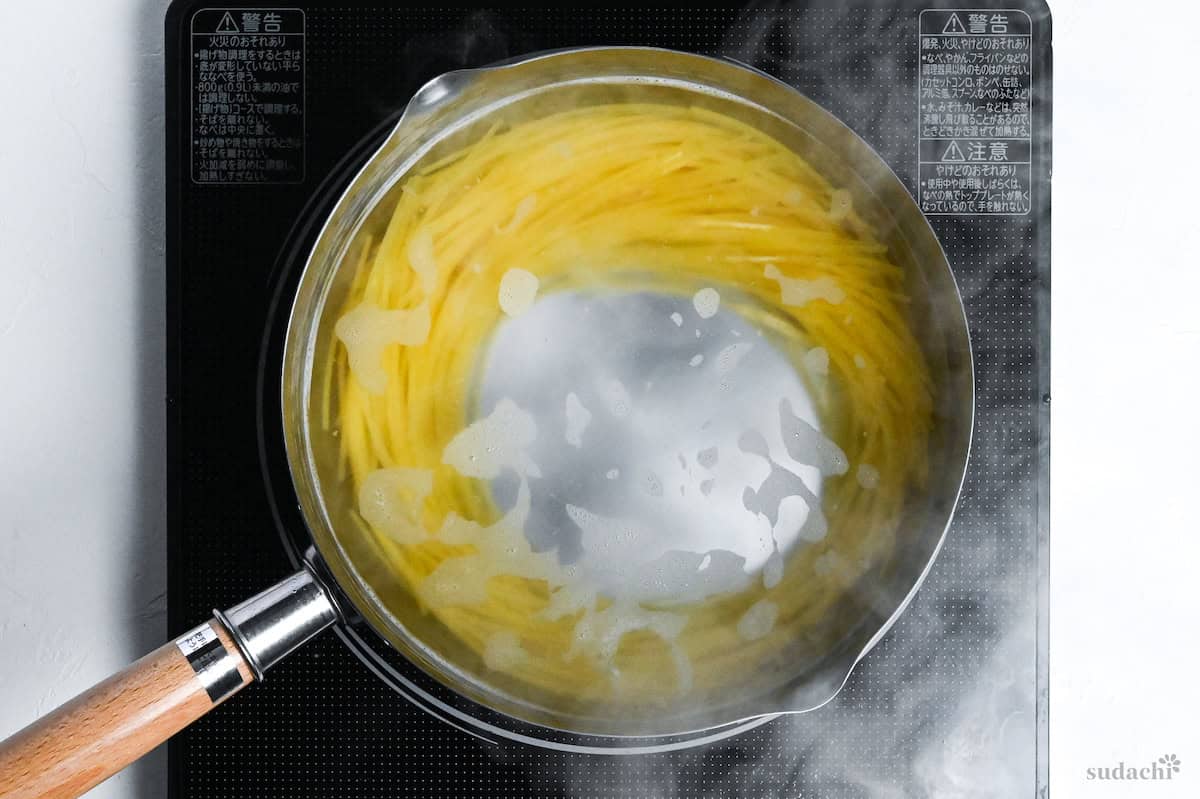
Overcook by a smidge now because the ice bath firms the noodles. Skip this, and your pasta will seize up and feel underdone once chilled.
ii. The moment your pasta finishes cooking, drain it quickly in your prepared colander, then immediately plunge it into the ice water bath. Swish the noodles around for about 30 seconds until they feel completely cool to the touch.
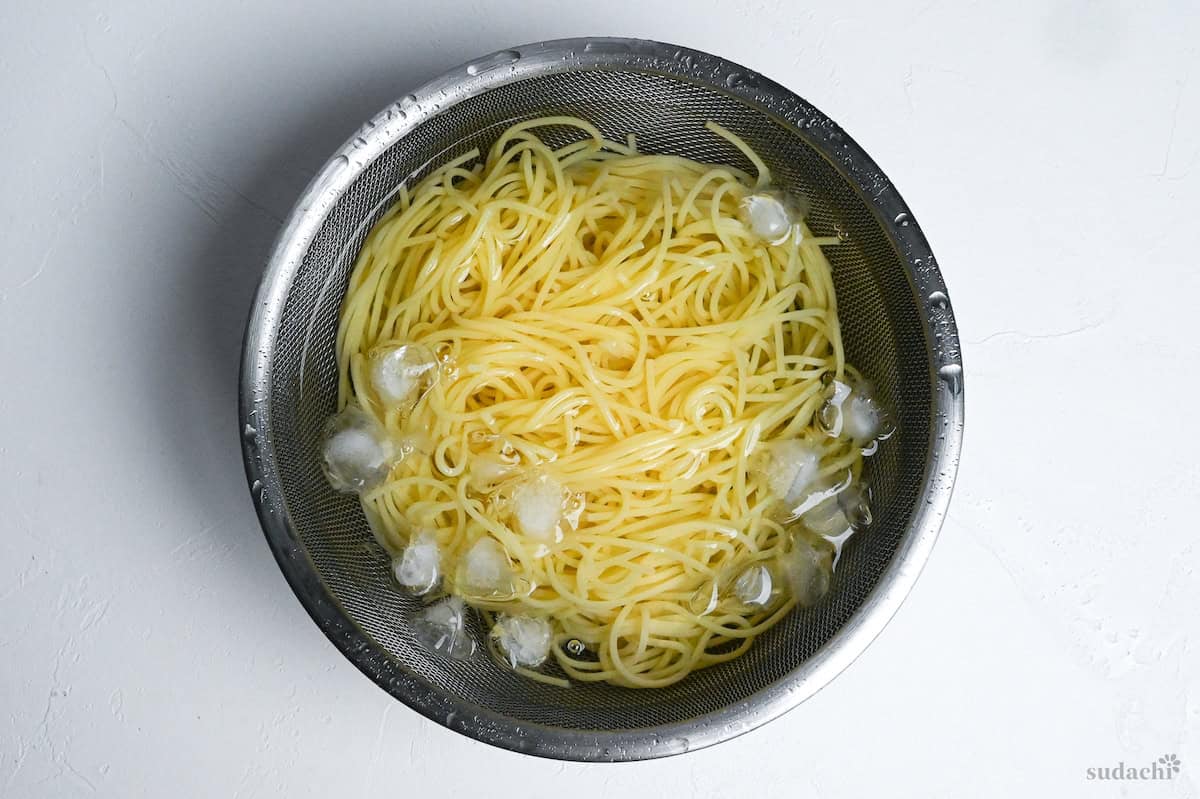
i. Transfer your well-drained pasta to a large mixing bowl.
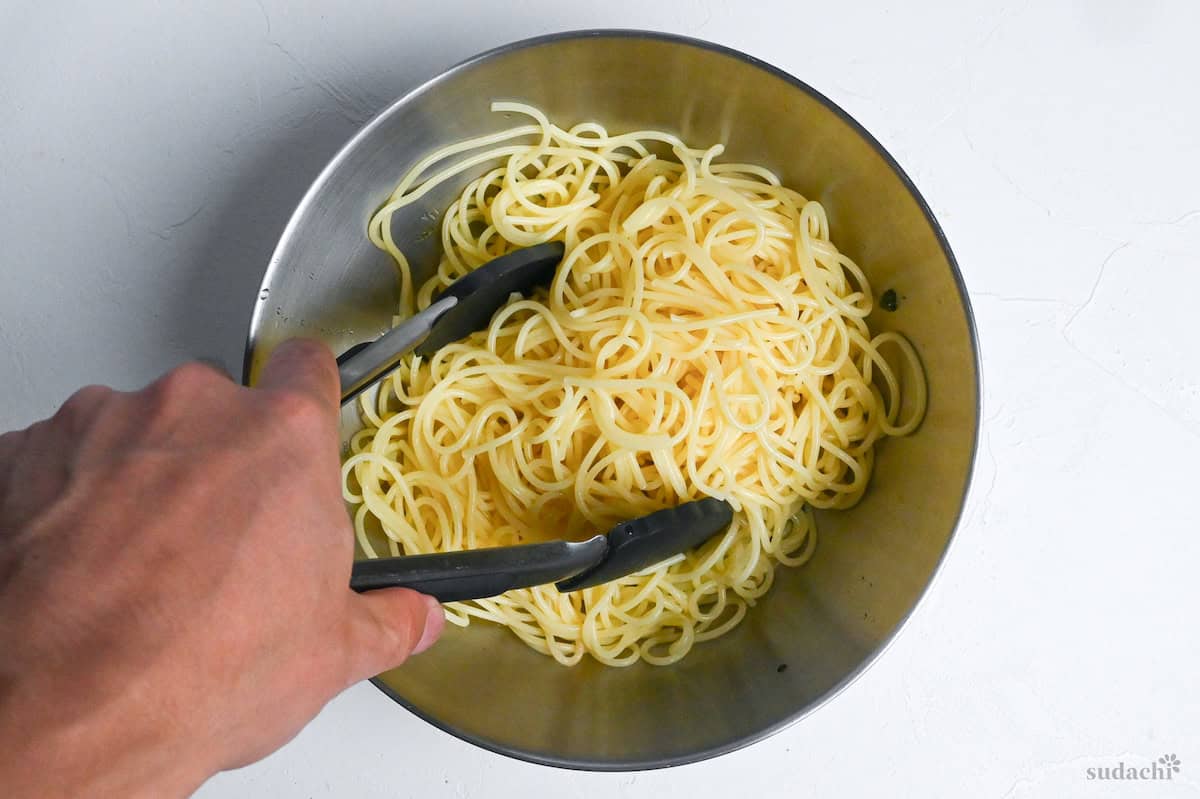
ii. Add the shiso pesto, tossing gently but thoroughly until every strand glistens with that beautiful green coating.
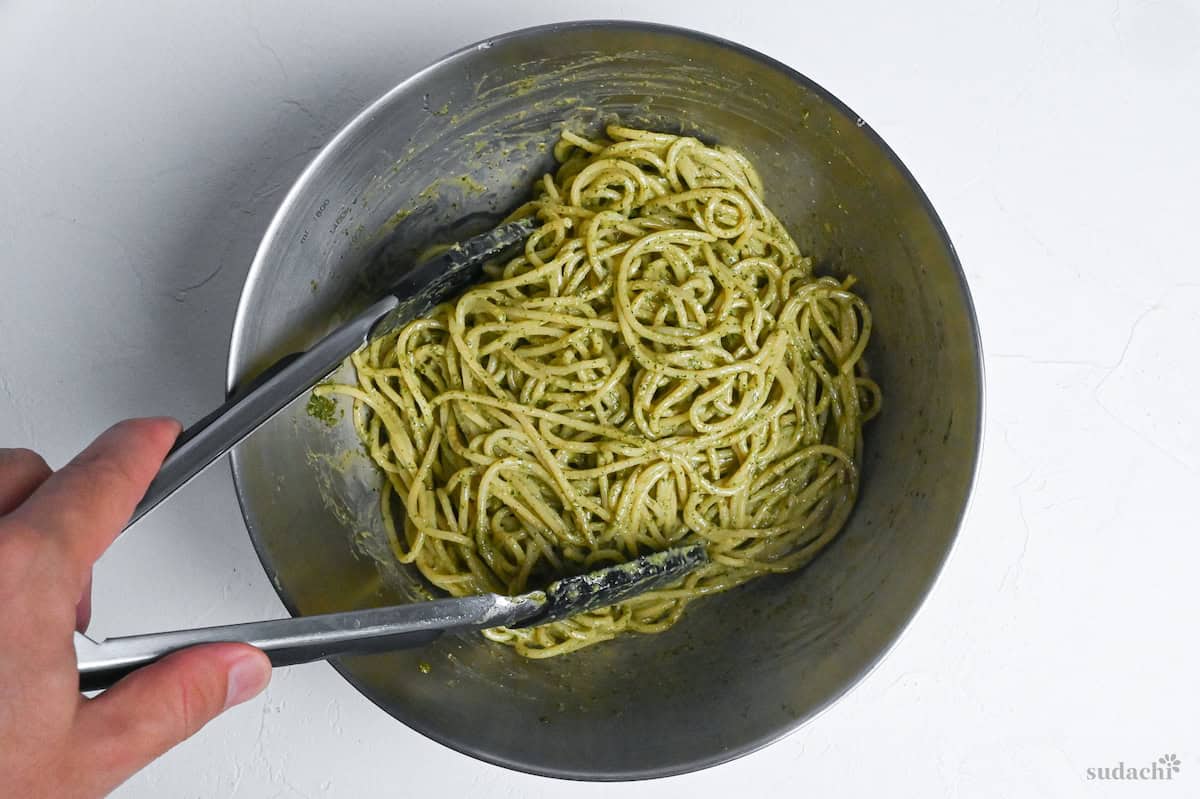
iii. Divide between your chilled serving bowls and spoon the marinated tomatoes generously over the top, letting some of that bright marinade pool around the edges.

iv. Finish with a drizzle of your best extra virgin olive oil.

v. If you want some meaty topping, I recommend using dry cured ham to keep the dish refreshing!
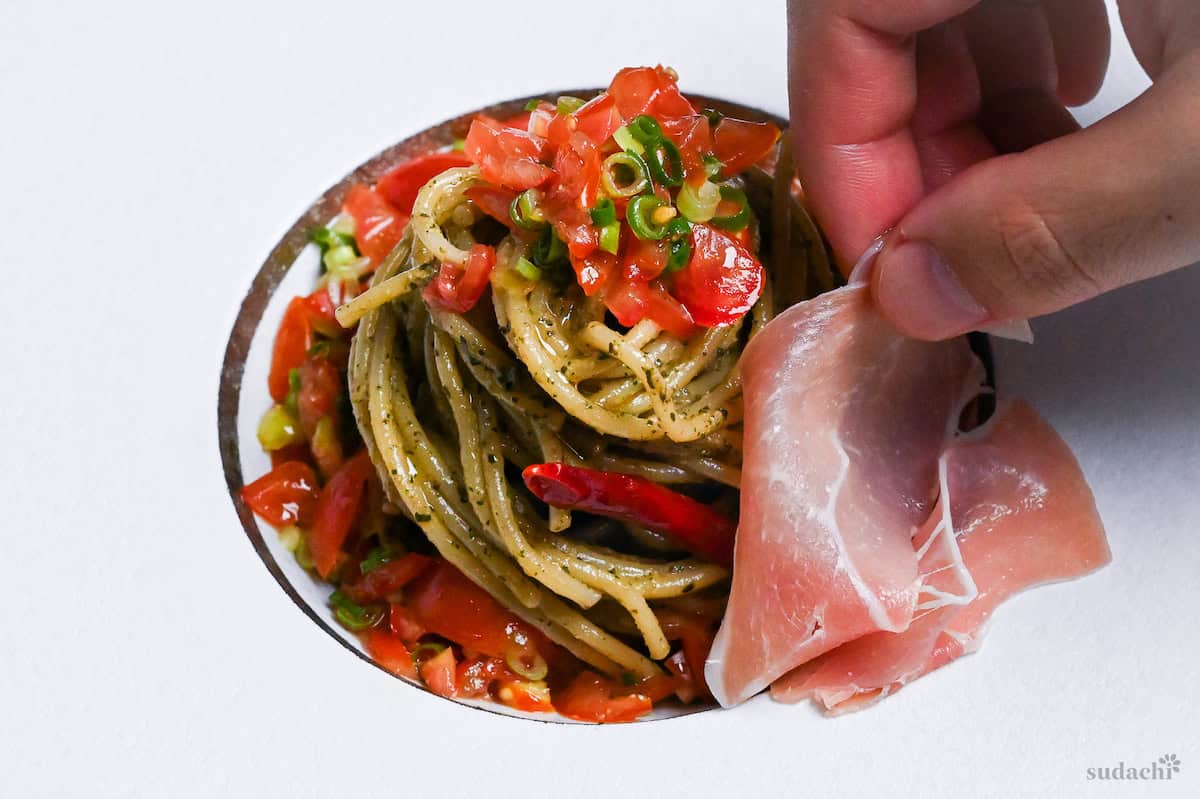
vi: A stunning plate of emerald-green pasta crowned with jewel-bright tomatoes, ready to impress your dinner guests or treat yourself to something special on a summer night.
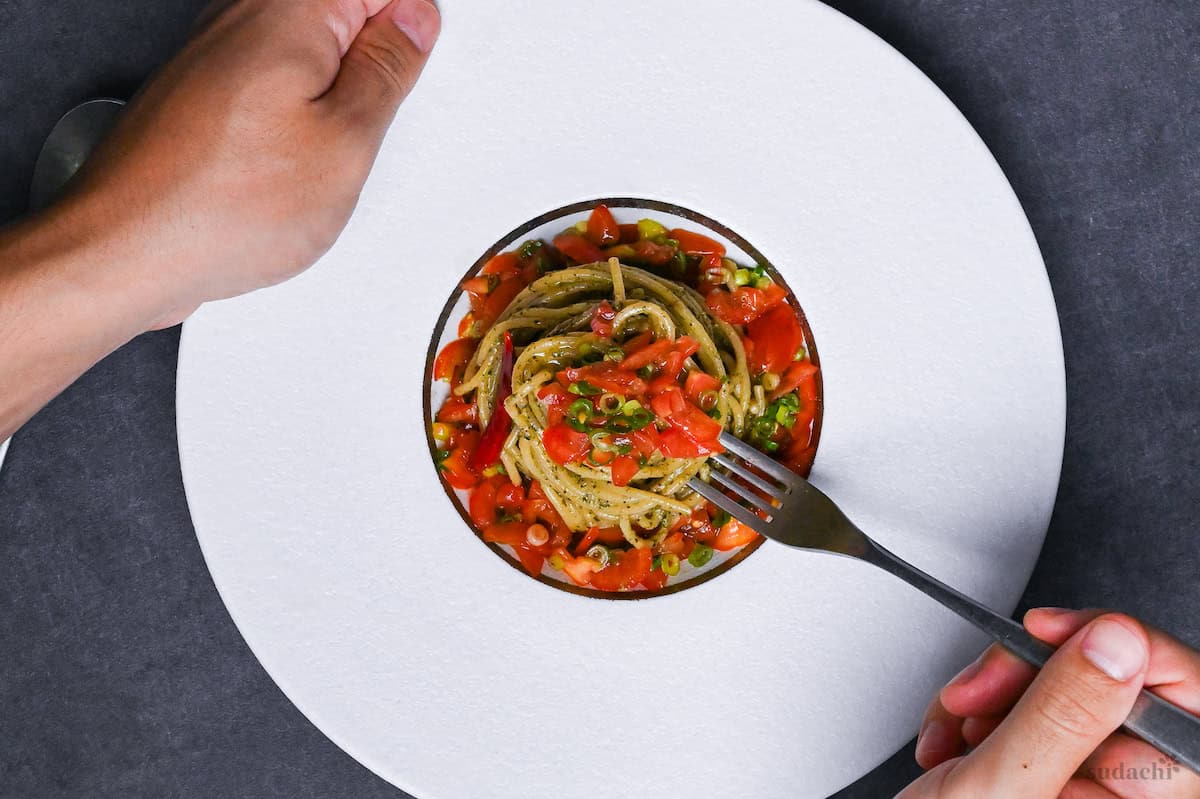

Essential Tips & Tricks
- Remove the garlic core to prevent harsh, lingering bitterness.
- Use a food processor or blender. Shiso is coarse and needs a fine grind compared to basil.
- Prep your ice water bath before the pasta finishes cooking.
- Cook pasta 1 minute longer than package directions.
- Drain pasta thoroughly after ice shocking.
With these simple tips in mind, you’re set for success every time you make this summer shiso pasta.
Storage & Meal Prep
Fridge: Store components separately. Marinated tomatoes (airtight): 2-3 days. Shiso pesto (jar, thin oil layer on top): 3-4 days.
Freezer: Pesto only. Freezer-safe container, up to 1-2 months.
Meal Prep: Make pesto and marinated tomatoes up to 2 days ahead, store separately.
What to Serve With This Recipe
Shiso Pesto Pasta Q&A
Absolutely! Slightly wilted shiso actually works better in the food processor since the leaves are more pliable. Just avoid any leaves that are completely brown or slimy.
Not recommended. Shiso leaves are much tougher than basil and need the processor’s powerful blades. A blender works, but you need to stop and scrape often.
Yes. Skip the ice bath. Reserve some pasta cooking water, toss off heat with pesto to make a silky, warm sauce.
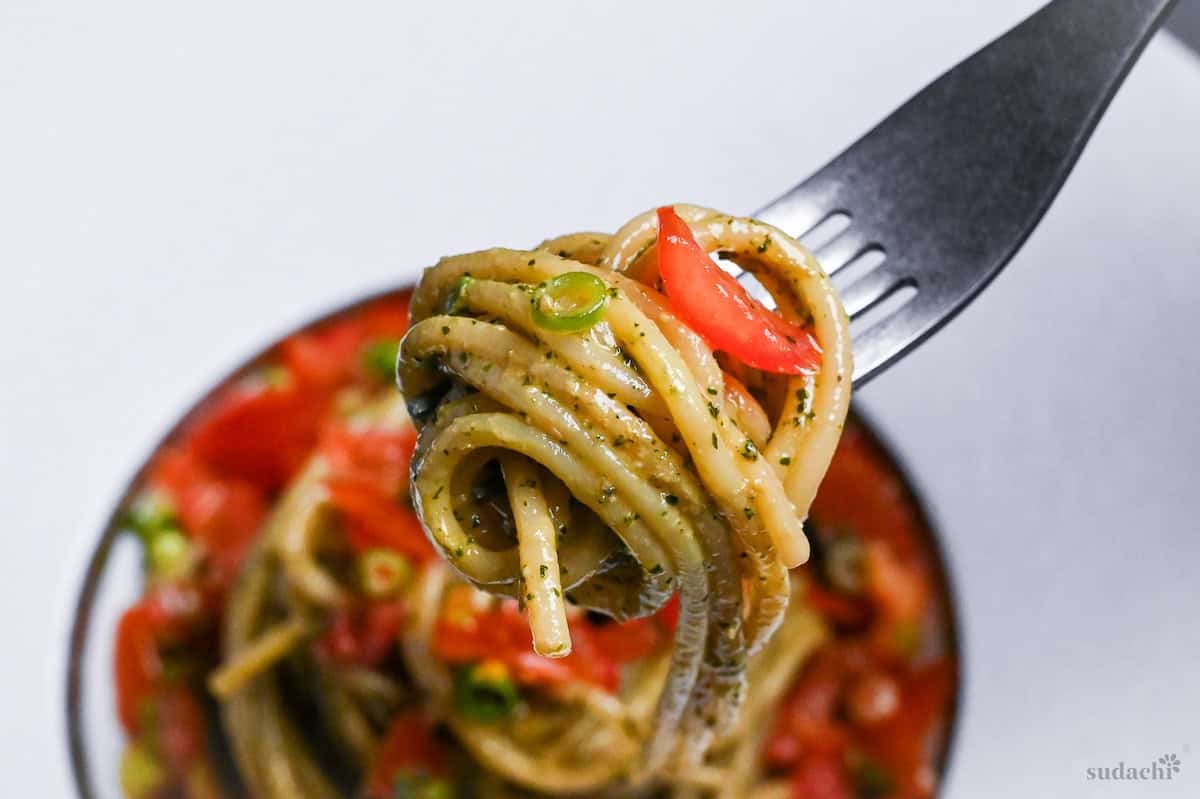
More Summer Noodle Recipes
When the weather heats up, cool down with the best summer noodle recipes featuring chilled and refreshing Japanese dishes.
Did You Try This Recipe?
I would love to hear your thoughts!
💬 Leave a review and ⭐️ rating in the comments below. 📷 I also love to see your photos – submit them here!
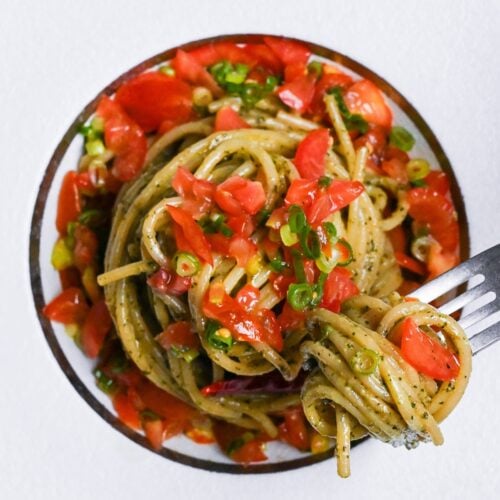
Cold Shiso Pesto Pasta
Ingredients
- 200 g dry spaghettini or capellini, spaghetti
- water approx 1 liter for every 100g of spaghetti
- salt for boiling pasta, about 1% of the weight of water
- olive oil to drizzle at the end, preferably extra virgin
Marinated Tomatoes
- 10 mini tomatoes cherry, grape
- 2 tbsp finely chopped green onions
- 2 tbsp olive oil preferably extra virgin
- 1 tsp lemon juice fresh or bottled
- ½ tsp balsamic vinegar
- ¼ tsp honey
- 1 dried red chili pepper deseeded, halved lengthways
- 1 pinch salt and pepper
Shiso Pesto Sauce
- 2 ½ tbsp olive oil preferably extra virgin
- 1 tbsp grated parmesan cheese or Pecorino, powdered cheese, nutritional yeast (plant-based option)
- ½ tbsp toasted white sesame seeds
- ½ tsp salt
- ½ tsp white miso paste
- ¼ tsp ground black pepper
- ¼ tsp anchovy paste or soy sauce, more white miso paste
- 15 g perilla leaves (shiso)
- 10 g cashew nuts unsalted, roasted
- 5 g pine nuts
- ½ clove garlic core removed
My recommended brands of ingredients and seasonings can be found in my Japanese pantry guide.
Can’t find certain Japanese ingredients? See my substitution guide here.
Instructions
- Roughly cut 10 mini tomatoes and place them in a bowl along with 2 tbsp finely chopped green onions, 2 tbsp olive oil, 1 tsp lemon juice, ½ tsp balsamic vinegar, ¼ tsp honey, 1 dried red chili pepper, and 1 pinch salt and pepper. Mix well, then cover and rest in the refrigerator for 30 minutes.

- In a food processor, add 2 ½ tbsp olive oil, 1 tbsp grated parmesan cheese, ½ tbsp toasted white sesame seeds, ½ tsp salt, ½ tsp white miso paste,¼ tsp ground black pepper, ¼ tsp anchovy paste, 15 g perilla leaves (shiso), 10 g cashew nuts, 5 g pine nuts and ½ clove garlic. Blitz until smooth, then store in the refrigerator until serving time.

- Bring a large pot of water to a rolling boil and add salt. Mix well, then place 200 g dry spaghettini into the pot and boil for 1 minute longer than the packaging states. While it cooks, prepare a bowl of ice cold water.

- Once cooked, drain the pasta and transfer to the ice water bath. Swish them around for about 30 seconds or until they feel completely cool.

- Drain once more and shake thoroughly to remove excess water. Place the pasta in a large bowl and add the shiso pesto. Toss until every strand is evenly coated.

- Divide between serving bowls and top with the tomato mixture. Drizzle with olive oil and enjoy!






would you suggest what kind of dried red pepper
Hi Randy,
For this one, I went with takanotsume, a staple chili in Japan. Other good options are dried bird’s eye chilies, cayenne, or serrano.
Yuto
Hi Yuto, thanks for this recipe. I’d like to try it! Could you recommend online shops where I can get shiso leaves from? The Asian food shops where I live in the UK don’t have them.
Hi Sophia,
Really appreciate your interest in trying this! Back when I lived in England, I also didn’t see fresh shiso anywhere locally. I’ve briefly checked online and the only places I’ve seen it are online shops like Nurtured in Norfolk or Parkway Greens, but they do come at a higher cost for what it is. If you enjoy gardening, Yorkshire Seeds sells shiso seeds you can grow yourself, or you can use basil instead with a touch of mint as a substitute.
Yuto
Dear Yuto,
I finally managed to grow perilla on my balcony and boy do they grow ☺️ Just made a triple patch of your shiso pesto with them and it is soo delicious!!! Thank you once again for a great recipe ❤️ Cannot wait for your cookbook to arrive 😍
Greetings from the other side of the world,
Dee
Hi Dee,
Thank you so much for tryin this recipe! So happy to hear your balcony shiso is thriving and that you made a triple batch of pesto with it! That sounds amazing! I’m really glad you enjoyed the flavors, and it means a lot that you’re looking forward to the cookbook! 🙂
Yuto